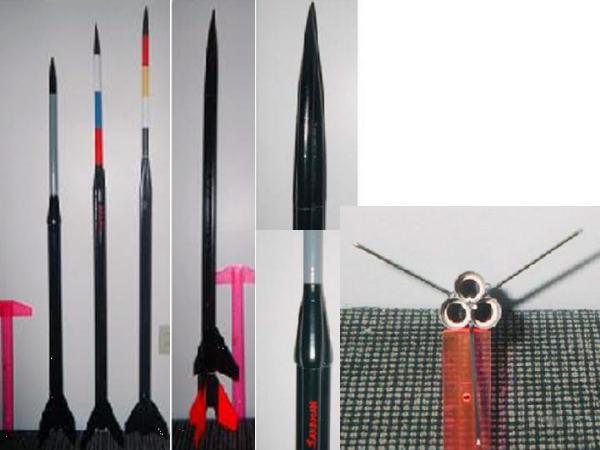| Manufacturer: | Scratch |
SANDMAN
Dennis "Doctor DynaSoar" McClain-Furmanski's Descon-14 Entry

Leftest: Three versions, original left most
Midleft: Sandman with nosecone and 2nd stage
Top center: Nose cone
Bottom center: first 3-to1 payload transition
Right: Business end
The Sandman is the first of a series of minimum diameter cluster designs intended to test the scaling up of an airframe while only scaling up to higher power building techniques as testing proves necessary. Essentially, it is building for performance while combating overbuilding. Materials are all "model rocket" quality, light paper tubes, medium weight balsa or basswood, and wood glue.
The core of the design is 3 clustered 24mm tubes. This provides 2/3 of the frontal cross section as a single tube containing the motor tubes. To maintain the benefit in lower drag, different configurations of three-to-one tube complex curved transitions have been sculpted, as has a nose cone for testing without payload sections.
The airframe is three 24mm tubes glued together along their 30 to 34" length. Except for motor and recovery equipment areas, the tubes have been drilled along their contact lines so the glue can "rivet" through these. Three fillets the full length of the tube offer a great deal of strength to the airframe. (Interesting aside: the first model was left on top a hot car roof during a launch. An hour later it had a 10 degree curve along the body. This remained the next day after it had cooled. I thought it was ruined. A week later, with no effort applied at all it was perfectly straight again, and eventually flew beautifully. This leads one to wonder how often the old LPR technique of straightening misaligned fins by heating the glue fillets over a light bulb resulted eventually became misaligned again.)
Engine mounting is Estes E size (3.75") engine hooks topped with a 20/50 centering ring as an engine block. Hook ends are to the inside of the cluster and a small slice of 24mm tube is glued over the top of the hook as an anchor. Shock cord is doubled loop ¼" elastic mounted 4 inches inside one of the tubes. The other tubes contain chutes and/or streamers.
The fins, balsa or basswood, are sanded to a sharp edge on the root and glued between two tubes. This increases the surface area of the fin contacting body tube, increasing adhesion. Fillets are wood glue. The first version required repeated puncturing and filling in of bubbles in the fillets due to the large amount of glue used, especially on the fillets between tubes. This was prevented on the others by doing the fillets in many layers. Launch lugs are glued against one fin root, and with the addition of a piece of dowel between the tubes as a stand off, near the top of the body.
Finishing is first, spray lacquer sanding sealer, on everything. Fins are sanded and a second coat is added and sanded. Then primer, followed by white satin finish, covered with black gloss (except booster, which is flat black "high heat" stove paint and fluorescent orange). The payload sections are painted (and named) gray, to match the Sandman costumes in "Logan's Run", blue red and white of the Russian flag (named "Mechtayu", meaning to dream) and the traditional four colors of the four races from Native American history (named "Dreamcatcher").
First flight of the Sandman was with the nose cone instead of payload section, on three C5-3's in 18 to 24mm adapters. The flight was flawless and higher than expected. At ejection, the parachute failed to open. However, the large size but light weight allowed the rocket to float slowly down horizontally, and it suffered no damage. The second flight was on three E9-6's. Due to wind, and the testing with several rockets previous to the flight, it was launched upwind. Again the flight was flawless, but again the chute didn't open, however it did display the same gentle horizontal descent. Due to the trajectory, it landed in an inaccessible swamp. The lesson learned is, 24mm is hard on plastic chutes. Unless there's a significant payload, streamers may be enough for this rocket; weight with payload section before loading engines is from 6 to 7 ounces. A streamer will definitely be used on the two stage test, when six E9 engines will push a total of 171 n/s. After these are fully tested repeated and examined for stress damage, the next versions will be 29mm with enough engine space for the longest available 29mm motors. Both wood glue and epoxy versions will be built for comparison testing.
 |
 |